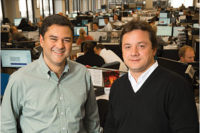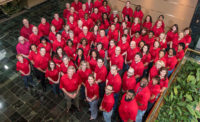David Van Eekeren, CEO and president of Lansing, Ill.-based Land O’Frost, in accepting The National Provisioner’s 2012 Processor of the Year honor, shared the secret to his company’s success.
“What we did is, we didn’t change our plan,” he states with a smile as to the simplicity of the concept.
That plan, set in motion roughly four years ago — and locked in place even through the tumultuous economic conditions of the past few years — has allowed Land O’Frost to boast a successful portfolio of innovative new-product launches that continue to bring consumers the value they seek. Furthermore, it has allowed Land O’Frost to post a growth curve that has outpaced its overall category in each of the last 10 years — including, Van Eekeren points out, the last two or three years of recession and inflation.
“Being solid on what we wanted to accomplish, we said, ‘Fine, we're in recession. We understand that we will take a turn for the worse, but our consumers shouldn't,’” he explains. “and we stuck with our plan — started in 2008 — to double the size of the company in five years.”
Van Eekeren admits that the decision to continue to grow at the expense of some profits over a year or two during the worst of the economic crisis was not an easy one, but the company came back to its mantra that if you're not growing then you're dying.
“Growth at any cost can't happen, but growth at some cost will,” Van Eekeren says. “And we think [this decision] positions us for the future better than anyone else.”
Land O’Frost took the stance that it would have to make some market moves and price increases, and it took a short-term hit in terms of retail space and customers. Yet, Van Eekeren believes the longer-term results will be positive for the company.
“We had been pretty stagnant for several years on our price structure and the way we went to market,” he says. “Recessions cause you to challenge your paradigms, and we found some flaws in the way we went to market.
“Those nuggets were probably sitting there for several years, and while you're successful, you just kind of walk by them and agree to deal with them soon,” Van Eekeren adds. “But the recession meant we had to deal with them the last two or three years.”
On the operations side, Land O’Frost invested in technology to help make more consistent products with less giveaway — improving both yield and end product quality. On the business side, the company was forced to stand its ground on price negotiations in some instances, giving both parties the best value.
One less-heralded move occurred when Land O’Frost decided to sell its specialty-meats division in 2011, as inflationary pressures built on the business. Van Eekeren says the company could not justify producing the products for its foodservice customers as prices rose, and Land O’Frost shed the business and turned its focus to its retail core. At the end of the day, explains Bill Marion, vice president of manufacturing for Land O’Frost, even this negative-perception move had a positive impact on operations.
“That shift in complexity, particularly in our Lansing plant, really accommodated some major leaps forward in terms of efficiencies, yields and cost control,” Marion adds.
All these changes have helped Land O’Frost grow behind the scenes, simply at a slower pace, as Van Eekeren says. But the company also has experienced some big-ticket success and solid payoffs on more risky ventures over the past year, from new-product introductions and dual-branded items to the addition of R&D and marketing infrastructure and the acquisition of Wimmer’s Meats.
Building up
As some of Land O’Frost’s customers balked at the price negotiations during the recession, Van Eekeren says the company did lose some of them, and as such, had to lay off some employees. However, he says, that drop in numbers did not last long, and at presstime, the company was in the throes of re-employment and workforce growth — much of it focused on building the infrastructure to handle the anticipated growth curve as the economy rebounds and Land O’Frost reaps the benefits.
“We continue to invest in people to give us better information systems,” he says. “We've probably had more growth in what I’ll call ‘non-production’ people than anywhere else in the organization in the last two or three years.”
Dave Funk, senior vice president Sales & Marketing, was hired in early 2011, and is just one example of the company’s dedication to building out the product-management side of the business.
“We are going down the whole brand-management concept, which Land O’Frost didn’t have before,” Funk explains. “We have a very specific, rifle focus on our brands. … We're very active in new-product development, which is the lifeblood of the organization, and our growth plans are ambitious.
“We're going to do it with very innovative thought processes and ideas, and keeping our finger on the pulse of the trends and where the consumer wants to go,” he adds.
Land O’Frost already has produced a variety of unique new products and a key partnership with Blimpie Subs that is expected to help make inroads into the northeastern United States, a region in which it has not had as much success with retailers. Funk explains that the Blimpie name is key to opening retailers’ and consumers’ eyes.
“They are a strong regional player, and the stores in the Northeast where we haven't had distribution have reacted positively thus far,” he says. “So we begin building an awareness and distribution, and that was a big part of our thought process to co-brand with Blimpie.”
Funk expects Land O’Frost to continue to pursue dual-branding initiatives moving forward, based on the success that products across all industries have had in branding partnerships. Of course, Land O’Frost will also focus on improving its own branded products.
“We continue to look at ways to improve the product through product enhancements,” he says. “We're looking at potentially some sodium reduction — but those types will likely not be flagged on the product, because they're simply improving the product overall.”
Building awareness and demand for Land O’Frost’s high-value brands, such as Premium and the higher-end Bistro Favorites line, will continue to drive organic growth, says Van Eekeren.
“Bistro Favorites is differentiated not only in the packaging but the look of the product and the way it’s processed and sliced,” he explains. “And that’s what excites me about it — it’s like Premium was in its infancy.”
As retailers and consumers continue to look for higher-end products, the Bistro Favorites products will thrive, says Van Eekeren.
“Where the one-pound Premium product is all about the families of four plus, the Bistro experience is really for someone who is looking more for a higher-end, deli experience,” he states. “So hopefully we're convincing consumers to walk away from the service deli and pick up Bistro products on the packaged-deli side.”
Bolting on
Van Eekeren believes the acquisition of the Wimmer’s product line offers a third option for company growth, as does any future acquisitions the company may make.
“We're not backing off on the acquisition front,” he explains. “While we're not pursuing it as aggressively as we were the last three years, we know that will spur more opportunities, because we’ve had some conversations since [the Wimmer’s acquisition closed].”
Despite the residual excitement around Wimmer’s, Van Eekeren understands that the company can’t go off on a shopping spree and lose sight of the business at hand, saying that the Land O’Frost team will immerse itself in Wimmer’s, understand it fully and then create growth in that business. Fortunately, incorporating Wimmer’s has been made easier by the fact that the two companies were quite similar.
“They had the same culture, the family stories were similar, and the way they thought about their business was the same,” Van Eekeren recalls. “It was a breath of fresh air, because every other company we talked to there was always a hiccup where it was not quite the same as us.”
Furthermore, Land O’Frost had targeted sausage as a product it hoped to bring on board, but not a commodity product — a specialty sausage processor was an ideal fit.
“That really attracted us [to Wimmer’s], that even though they make a hot dog, it's a high-end, natural casing hot dog that sells for five to six times more than your generic or standard commodity hot dog,” Van Eekeren says. “We always wanted a strong regional brand as well.”
Beyond acquisitions, Land O’Frost can expand within its current framework, through facility additions, process improvements and other avenues.
“There is definitely capacity at all three facilities and as we invest in more automation, we're going to develop capacity as well,” Van Eekeren adds. “Ultimately, if we do have to add footprint, there's expansion of the Kentucky facility that can happen, and the Wimmer’s facility has some expansion capability.”
Van Eekeren affirms that the new products, the Wimmer’s acquisition and all the new infrastructure locks in tightly with the overall goal of the company, as laid out when he took the reins of the company years ago.
“We have not given up on the concept of being the brand that your family can trust for generations,” he says. “From a dollars-and-cents and category standpoint, our goal is to be No. 1. It's going to take some time, and we're not naive to that, but our goal is to be No. 1 someday and do it in a family-oriented way with a family-held business.”












